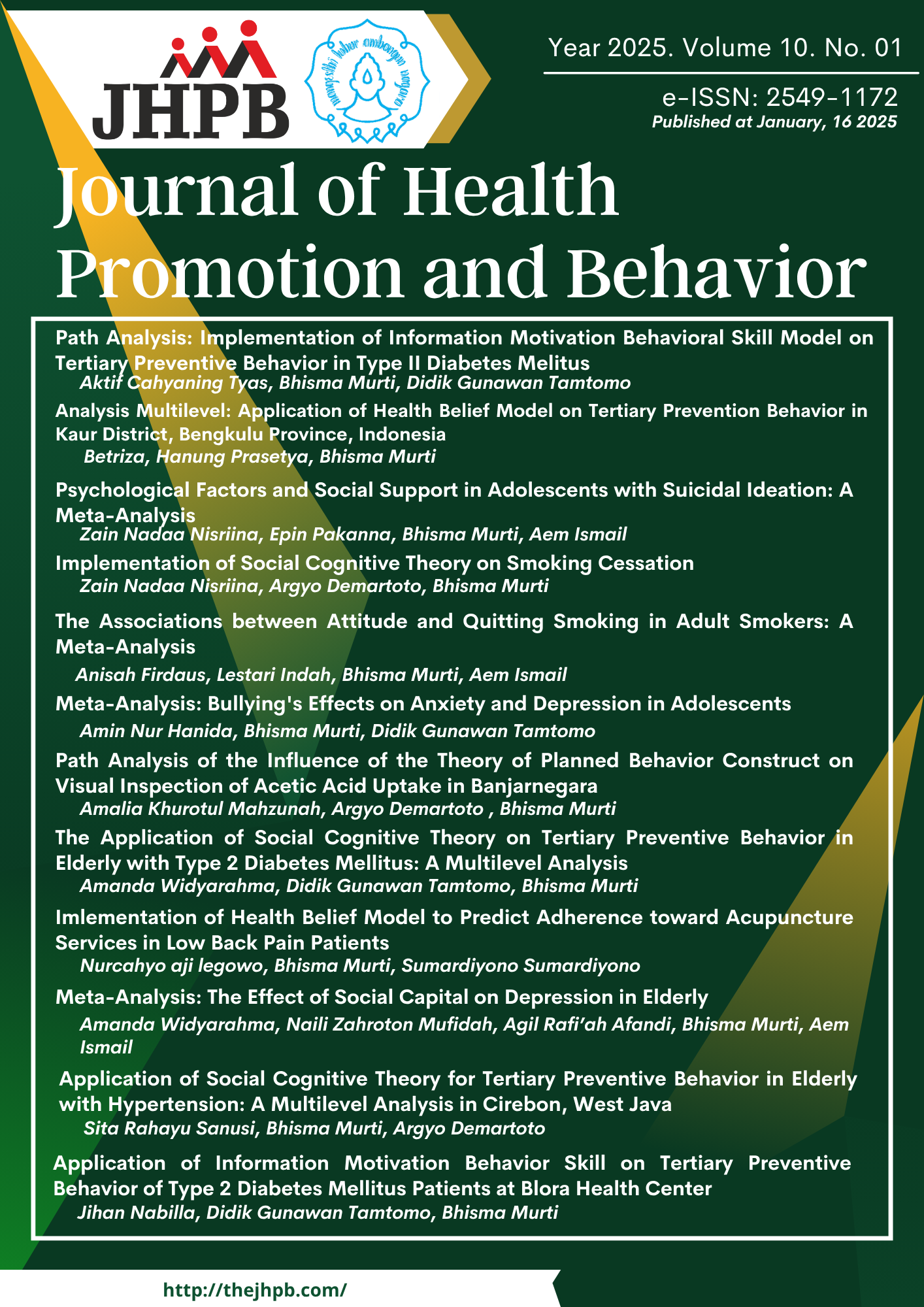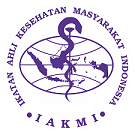Imlementation of Health Belief Model to Predict Adherence toward Acupuncture Services in Low Back Pain Patients
DOI:
https://doi.org/10.26911/thejhpb.2025.10.01.09Abstract
Background Adherence in using acupuncture services can reduce the risk of developing more severe low back pain. Low back pain patients who do not receive regular treatment will experience a high risk of injury. This study aims to determine the relationship between the construct of the health belief model and adherence in using acupuncture services.
Subjects and Method: This was a cross-sectional study carried at the Surakarta acupuncture clinic in December-March 2024. A sample of 200 low back pain patients was selected using random sampling. The dependent variable was low back pain patients. The independent variables were perceived vulnerability, perceived severity, perceived benefits, perceived barriers, cues to action, and self-efficacy. Data were analyzed using a multiple logistic regression.
Results: Adherence to acupuncture therapy in LBP patients increased with high perceived vulnerability (OR= 2.46; 95% CI= 1.09 to 5.07; p = 0.028), high perceived severity (OR= 4.07; CI 95%= 1.84 to 8.99; p = 0.001), high perceived benefit (OR= 2.57; 95% CI= 1.12 to 5.84; p = 0.024), had cues to action (OR= 2.24; 95% CI= 1.03 to 4.90; p = 0.042), and high self-efficacy (OR= 2.27; 95% CI= 1.03 to 5.00; p = 0.042). It was decreased by high perceived barriers (OR= -0.35; 95% CI= -0.15 to -0.80; p = 0.014).
Conclusion: Adherence to acupuncture therapy in LBP patients increases with high perceived vulnerability, high perceived severity, high perceived benefit, had cues to action, and high self-efficacy. It is decreased by high perceived barriers
Keywords:
Acupuncture adherence, health belief model, low back painHow to Cite
References
Asano H, Plonka D, Weeger J (2022). Effec-tiveness of acupuncture for nonspeci-fic chronic low back pain: a systematic review and meta-analysis. Med Acu-punc. 34(2):96-106. https://doi.org/-10.1089/acu.20-21.0057.
Azizi N, Karimy M, Salahshour V (2018). Determinants of adherence to tuber-culosis treatment in iranian patients: application of health belief model. J. Infec. Dev Ctries. 12(9):706-711. https://doi.org/10.3855/jidc.9653
Babazadeh T, Ghaffari-Fam S, Oliaei S, Sarbazi E, Shirdel A, Mostafa-Gharabaghi P, Azizi H (2019). Predictors of pap smear screening behavior among rural women in tabriz, Iran: An application of health belief model. Int. J. Cancer Manag. 12(5). https://doi.org/10.58-12/ijcm.87246
Fallucca A, Immordino P, Riggio L, Casuccio A, Vitale F, Restivo V (2022). Acceptability of HPV Vaccination in Young Students by Exploring Health Belief Model and Health Literacy. Vaccines. 10(7). https://doi.org/10.3390/vacci-nes10070998
Ferreira L, de Luca K, Haile M, Steinmetz D, Culbreth T, Cross M, Kopec A, et al. (2023). Global, regional, and national burden of Low Back Pain, 1990–2020, its attributable risk factors, and projections to 2050: a systematic analysis of the Global Burden of Disease Study 2021. Lancet Rheumat. 5(6):e316–e329. https://doi.org/-10.1016/S2665-9913(23)00098-X
Ifrim F, Antochi A, Gheorghe A. (2019). Acupuncture and the retrospect of its modern research. Rom J. Morphol. Embryol. 2019(2):411–418. http://-www.rjme.ro/
Juliawati M, Berhimpong A, Joy A, Rattu M, Maja J. (2020). Analisis Implementasi Aktivitas Fisik Berdasarkan Health
Belief Model oleh Tenaga Kesehatan di Puskesmas (Analysis of the Imple-mentation of Physical Activity Based on the Health Belief Model by Health Workers at Community Health Centers). J Pub Health Comm Med. 1(4). https://doi.org/-10.35801/-ijph-cm.1.4.2020.31453
Khodaveisi M, Azizpour B, Jadidi A, Mohammadi Y (2021). Education based on the health belief model to improve the level of physical activity. Phys Act Nutr. 25(4), 17–23. https://-doi.org/10.20463/pan.2021.0022
Knezevic N, Candido D, Vlaeyen S, Van J, Cohen P (2021). Low back pain. In The Lancet. 398(10294):78-92. https://doi.org/10.1016/S01406736-(21)00733-9
Laili N, Tanoto W (2021). Model Kepercaya-an Kesehatan (Health Belief Model) Masyarakat Pada Pelaksanaan Vaksin Covid-19. JIIKI. 17(3), 198. https://-doi.org/10.26753/jikk.v17i3.625
Lam S, Luerssen G, Hadley C, Daniels B, Strickland A, Brookshier J, Pan W (2017). The health belief model and factors associated with adherence to treatment recommendations for posi-tional plagiocephaly. J Neurosurg Pediatr, 19(3):282–288. https://doi.-org/10.3171/2016.9.PEDS16278
Montanaro A, Bryan D (2014). Comparing theory-based condom interventions: health belief model versus theory of planned behavior. J.Health Psychol. 33(10), 1251–1260. https://doi.org/1-0.1037/a0033969
Moradi Z, Tavafian S, Kazemi S. (2022). Educational intervention program based on health belief model and neck pain prevention behaviors in school teachers in Tehran. BMC Public Health. 22(1). https://doi.org/10.1186/s12889-022-13873-8
Rosenstock M, Strecher J, Becker H (1988). Social Learning Theory and the Health Belief Model. Health Education & Behavior. 15(2), 175–183. https://doi-.org/10.1177/109019818801500203.
Tareke G, Tesfaye G, Koricha B (2022). Development and validation of Health Belief Model based instrument to assess secondary school student’s adherence to COVID-19 self-protective practices in Jimma, Oromia, Ethiopia. PLoS ONE. 17(12).https://doi.org/-10.1371/journal.pone.0279440
Ting Yih J, Mohd A, Naffi A, Mustapha M, & Wan WH. (2023). Determination of Factors Influencing the Health Belief Model (HBM) and Adherence to Intravitreal Anti-vascular Endothelial Growth Factor (VEGF) Among Pati-ents With Diabetic Macular Edema (DME). Cureus. https://doi.org/10.7-759/cureus.34669
Tong K, Chen H, Yu E, Wu S (2020). Adhe-rence to COVID-19 Precautionary Measures: Applying the Health Belief Model and Generalised Social Beliefs to a Probability Community Sample. Applied Psychology: Health and Well-Being. 12(4), 1205–1223. https://doi.-org/10.1111/aphw.12230
Urits I, Kway J, Yancey K, Mousa M, Won J, Berger A, Mohammad I, et al. (2021). Acupuncture for the management of low back pain. Acupuncture for the management of low back pain.1(2)-124-156 https://doi.org/10.1007/s11-91602000919-y/Published.
Yu B, Zhou J, Gong Y, Han J, Dong P, Yang S, Liao R, Guan P, Yang S (2020). Self-efficacy Mediates Perceived Benefits and Barriers of Adherence of Heroin-dependent Patients to Methadone for Addiction Treatment: A Health Belief Model Study. J Addict Med. 14(4), E110–E117.https://doi.org/10.1097/-ADM.000-0000000000640.




